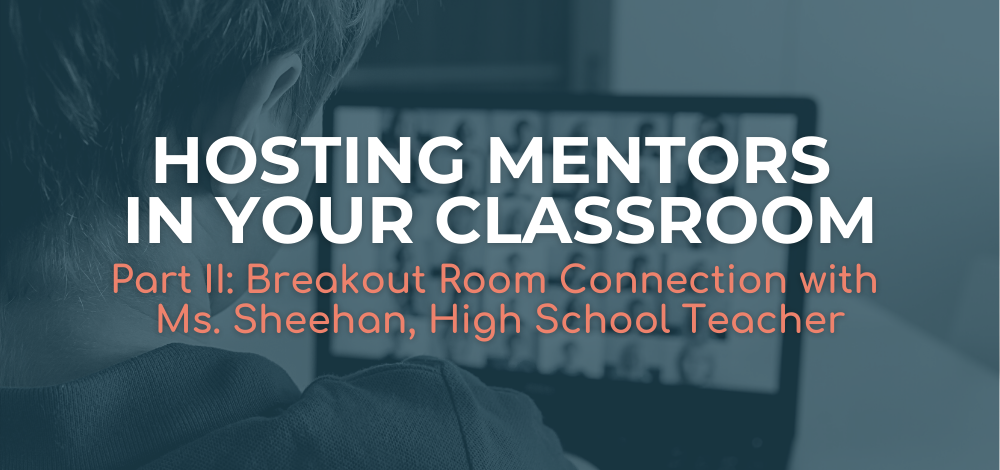
Mentors provide a judgement-free environment for BPS teens and help limit missed connections
High school educators across the district have spent the past year navigating how to support teenagers in a virtual world. One Fenway High School teacher found that while students always need academic help, social support has become essential.
Ms. Sheehan has used BPIE academic mentors in her classroom before. Last year, when classes were still in-person, she hosted between two and three volunteers – this year in the virtual classroom, she hosts thirteen. Ms Sheehan places mentors in breakout rooms in order to forge a connection with students and improve communication. “In person, I could overhear their conversations when walking around the classroom, but in breakout rooms I can’t, so that’s challenging – you want to know that they’re doing okay.”
This school year, when Ms. Sheehan decided to add mentors to breakout rooms, her students responded with high praise. “I have two classes that are close to twenty-five or twenty-six students and it’s really helpful to have somebody in there. Students are saying that with the mentors, they feel supported and confident”
Before welcoming a mentor into her classroom, Ms. Sheehan reminds them that human connection is key. “I always tell them to make sure that they spend time chatting with the students first.” She stresses the importance of conversation and instructs volunteers to chat about whatever they have in common before focusing on the math. “We have to get to know students and it’s important for students to get to know us too. Then, it increases their learning – it’s those little things that we now have time for.”
Ms. Sheehan has witnessed trust grow between mentoring pairs – she sees that students aren’t as afraid to make mistakes or share personal stories. “It’s a safe place because no one there is going to judge them,” she explains.
Having mentors in her online classrooms has also afforded Ms. Sheehan time to regain small but significant check-in moments with her students. At the onset of remote learning, sticky notes began accumulating around Ms. Sheehan’s “work from home” station as she worked tirelessly to keep up with all of her students. She used Post-its as reminders to ask about siblings, parents, and pets. If a student mentioned their sister was sick, she’d make a note to check-in about that later.
“I was making lists of kids who are a priority to talk to and it never felt like I could get to everybody because there’s just so much need.”
As we learned in Part I of this series with Ms. Crawford and her kindergarten classroom, mentors can be an essential extension of a teacher in situations like this. “It’s wonderful that they can be my extra eyes and ears in the classroom,” says Ms. Sheehan.
While it might be surprising to think that five-year olds and fifteen-year olds are facing similar challenges in school right now, our conversations with Ms. Crawford and Ms. Sheehan both emphasize the increased need for social support in a digital world. What came naturally before, has turned tricky with technology, especially when it comes to fostering classroom conversation.
“Zoom only allows one person to speak at a time, so if you want to have really rich discussions sometimes it gets awkward – one person goes to unmute to say something but then someone else is talking.” Ms. Sheehan explains that while the chat option is available, conversation doesn’t flow the same.
“It’s much better to have breakout rooms of like five or six students and the mentors work one-on-one which allows for students to have more time to say things that they need to say.”
Promoting healthy social interaction continues to be a challenge in remote high school classrooms. Ms. Sheehan recalls a moment in a 9th grade classroom that struck her. “One time my internet was unstable and I got kicked off – when I came back in, no one was talking to each other.” In a typical setting, a quiet classroom might be ideal, but Ms. Sheehan realized then, “none of them know each other.” To increase engagement and social interaction, she continues to use icebreakers with her students and asks mentors to do the same in breakout rooms.
“One of the questions that we ask is, have you met any friends or is there anyone that you are interested in getting to know?” Mentors become a bridge for student connection, they help build relationships between students, and allow teachers to keep track of little but meaningful moments.
Educators, no matter what grade they teach, have found that adding mentors to their classrooms strengthens social and academic connections for their students. “It makes me feel so much more supported because my job is to support the students and I’m doing that better through the mentors.”
